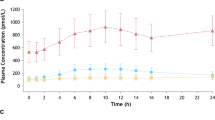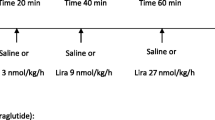Summary
A study was made of the influence of hydralazine on the oral availability of atenolol, a low clearance hydrophilic β- adrenoceptor antagonist. Atenolol (100mg) was given orally alone or in combination with oral hydralazine (25 or 50mg) on separate occasions to 6 normal healthy volunteers. Blood samples were collected post- dose over 9 hours and urine samples for 24 hours. Assays for atenolol were performed using a specific high pressure liquid chromatography technique.
Peak concentrations of atenolol, time to peak and area under the plasma concentration- time curve (AUC) were not altered by coadministration of either dose of hydralazine. Similarly, there were no differences in the urinary recovery or renal clearance of atenolol.
These results are in agreement with findings on coadministration of hydralazine with other β- blockers (nadolol, acebutolol) with low hepatic clearance, but contrast with the findings of increased AUC and peak concentrations when hydralazine was coadministered with propranolol and metoprolol.
Combination therapy with β- blockers and vasodilators is widely used, exploiting pharmacodynamic synergism. If vasodilator- induced changes in splanchnic blood flow mediate alterations in oral availability, then all high clearance β- blockers may show this interaction, indicating potential therapeutic advantage for those β- blockers which show low hepatic clearance.
Similar content being viewed by others
References
Benet, L.Z. and Sheiner, L.B.: Design and optimisation of dosage regimens: pharmacokinetic data; in Goodman and Gilman (Eds) The Pharmacological Basis of Therapeutics, pp. 1675–1737 (McMillan Publishing Co., New York 1980).
Brown, H.C.; Carruthers, S.G.; Johnston, G.O.; Kelly, J.G.; McAinsh, J.; McDevitt, D.G. and Shanks, R.G.: Clinical pharmacologic observations on atenolol, a beta-adrenoceptor blocker. Clinical Pharmacology and Therapeutics 20: 524–534 (1976).
Cruickshank, J.M.: The clinical importance of cardioselectivity and lipophilicity in beta-blockers. American Heart Journal 100: 160–178 (1980).
Daniel, W.W.: Applied Nonparametric Statistics (Houghton Mifflin Company, Boston 1978).
Fitzgerald, J.D.; Ruffin, R.; Smedstad, K.G.; Roberts, R. and McAinsh, J.: Studies on the pharmacokinetics and pharmacodynamics of atenolol in man. European Journal of Clinical Pharmacology 13: 81–89(1978).
Heinzow, B.G.J. and McLean, A.J.: Apparent flow-dependent hepatic clearance of propranolol incompatible with the venous equilibrium model of sinusoidal extraction. American Society for Clinical Pharmacology and Therapeutics, Abstract C20 (March 1982).
Henry, J.A.; Ohasi, K.; West, C. and Britton, K.E.: Acute effects of hydralazine and indoramin on renal function in man. British Journal of Clinical Pharmacology 12: 755–775 (1981).
Jack, D.B.; Kendall, M.J.; Dean, S.; Laugher, S.J.; Zaman, R. and Tenneson, M.E.: The effects of hydralazine on the pharmacokinetics of three different beta adrenoceptor antagonists: metoprolol, nadolol and acebutolol. Biopharmaceutics and Drug Disposition 3: 47–54 (1982).
McLean, A.J.; McNamara, P.J.; du Souich, P.; Gibaldi, M. and Lalka, D.: Food, splanchnic blood flow and bioavailability of drugs subject to first-pass metabolism. Clinical Pharmacology and Therapeutics 24: 5–10 (1978).
McLean, A.J.; Skews, H.; Bobik, A. and Dudley, F.J.: Interaction between oral propranolol and hydralazine. Clinical Pharmacology and Therapeutics 27: 726–732 (1980).
McLean, A.J.; Isbister, C.; Bobik, A. and Dudley, F.J.: Reduction of first-pass hepatic clearance of propranolol by food. Clinical Pharmacology and Therapeutics 30: 31–34 (1981).
Melander, A.: Influence of food on the bioavailability of drugs. Clinical Pharmacokinetics 3: 337–351 (1978).
Melander, A.; Danielson, K.; Schersten, B. and Wahlin, E.: Enhancement of the bioavailability of propranolol and metoprolol by food. Clinical Pharmacology and Therapeutics 22: 108–112 (1977).
Melander, A.; Stenberg, P.; Liedholm, H.; Schersten, B. and Wahlin-Boll, E.: Food-induced reduction in bioavailability of atenolol. European Journal of Clinical Pharmacology 16: 327–330 (1979).
Pang, K..S. and Rowland, M.: Hepatic clearance of drugs. I: Theoretical considerations of a ‘well stirred’ model and a ‘parallel-tube’ model. Influence of hepatic blood flow, plasma and blood cell binding, and the hepatocellular enzyme activity on hepatic drug clearance. Journal of Pharmacokinetics and Biopharmaceutics 5: 625–653 (1977).
Waal-Manning, H.J.: Hypertension: Which beta-blocker? Drugs 12: 412–441 (1976).
Walle, T.; Fagen, T.C.; Walle, U.K.; Oexmann, M.J.; Conradi, EC. and Gaffney, T.E.: Food induced increase in propranolol bioavailability. Relationship to protein and effects on metabolites. Clinical Pharmacology and Therapeutics 30: 790–795 (1981).
Weddle, O.H.; Amick, E.N. and Mason, W.D.: Rapid determination of atenolol in human plasma and urine by high-pressure liquid chromatography. Journal of Pharmaceutical Sciences 67: 1033–1035 (1978).
Author information
Authors and Affiliations
Rights and permissions
About this article
Cite this article
McLean, A.J., Wilhelm, D. & Heinzow, B.G. Stable Oral Availability of Atenolol Coadministered with Hydralazine. Drugs 25 (Suppl 2), 131–135 (1983). https://doi.org/10.2165/00003495-198300252-00038
Published:
Issue Date:
DOI: https://doi.org/10.2165/00003495-198300252-00038




